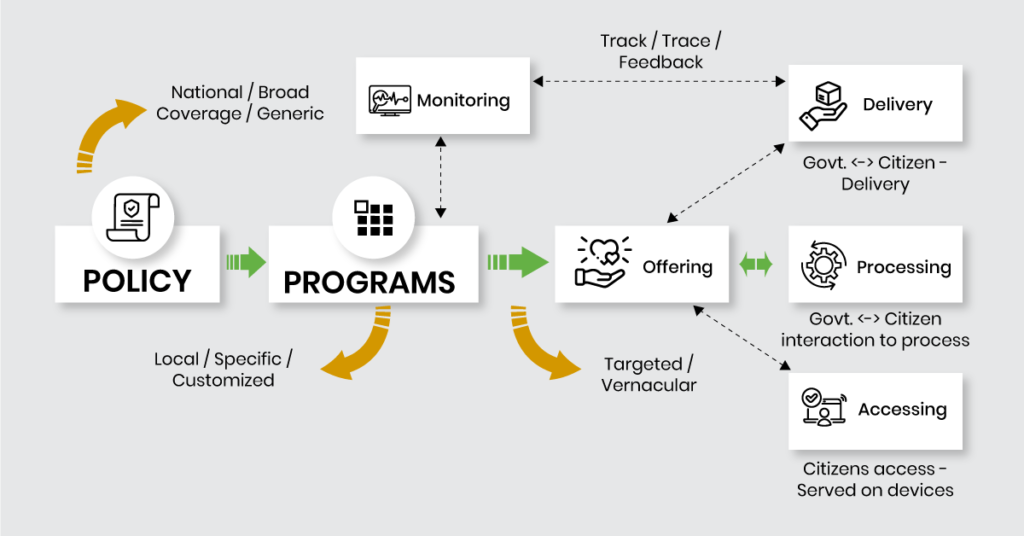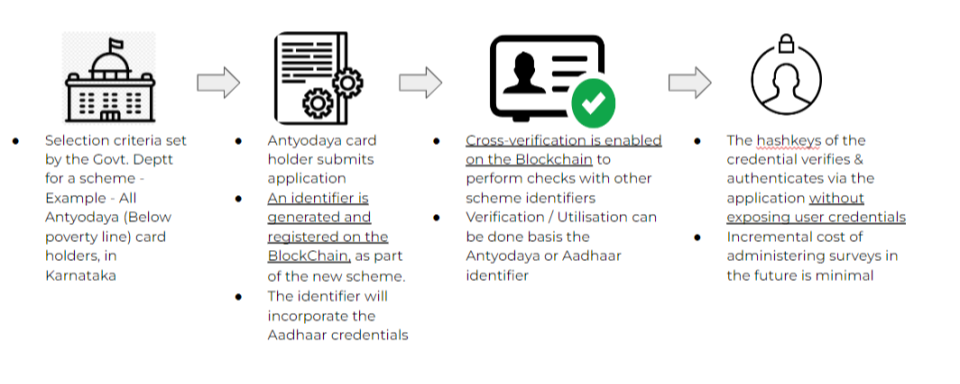Ease of welfare delivery on a Digital Public Infrastructure
Overview of Government’s role in welfare
The Directive Principles of State Policy, enshrined in Part IV of the Indian Constitution reflects that India is a welfare state. In the 2022 Union budget of India there are 740 central sector (CS) schemes. and 65 centrally sponsored schemes (CSSs). The government allocated Rs 4,42,781.19 crores for central sponsored schemes and Rs 11,81,084 crores for Central sector schemes.
Government (State & Centre) is the largest service provider in India for ~1.35 Bn citizens. Given the vast scope of government’s role in welfare, continuous improvement in service delivery and Innovation is critical to realize the vision of an Inclusive governance that can reach citizens across all strata of society.
Policy translating into action
Policies of the government express its broad intent to ensure that different segments of stakeholders in society are catered to appropriately for the smooth functioning of both commerce and welfare. This necessarily implies that policy intent will be broad brush, target and outcome focused at the aggregate level of the population. However, administrators translate policy intent to specific actions on the ground in line with the customization requirement that change both temporally and spatially.
The role of ministries in the central and state governments, with the support of NITI Aayog, is to formulate sector specific policies that can guide allocation of resources and implementation. These policies in turn influence design of programs contextualised to regions and their demography.

The district administration and the Panchayat Raj institutions are the last leg of policies translating to action on the ground. This encompasses the activities related to creating awareness, processing requests, delivering services and monitoring the overall implementation. Majority (65%+) of India is rural and the last mile delivery of services often involves multiple physical interactions including the need of a physical verification, at an office, at a specific time and location and in the presence of a verifying authority.
Ease of governance through technology
Technology is at the core of improving governance, not limited to improving service delivery of welfare.
India’s tryst with digital governance targeted at “Citizen – Govt interface” began in the 1980s significantly with automation of Railway reservations. This has exponentially expanded with the introduction of Aadhaar and its link with the Digital payment system (UPI) during the pandemic. India’s implicit policy regime of digitalization expects an expansion of Digital payment transactions per day to 1 Bn.
India’s capability to leapfrog into the area of digital governance is enhanced by the availability of digitized identities in the form of Aadhaar, Payment infrastructure (UPI) and Jan Dhan Bank Accounts (~47 cr).
Leveraging the large scale digitization in India, the government transferred Rs 5.52 trillion through Direct Benefit Transfers in 2020-21 when the pandemic hit the country
Despite the digitization of citizen identities with the aim of improving governance, there continues to exist the need of a verifying authority at the last mile of service delivery. India needs to move to the next step in governance with digitalization of these digitized identities leveraging the latest technologies.
Digitalization & the role of a DPI
With objective of easing and improving governance, the time is ripe for the incubation of the ecosystem of a Digital Public infrastructure for governance. This will involve the participation of foundational registries, verifiers, application developers, device providers, social sector organizations and a technology back bone based on Web 3 principles.
Digital Public Infrastructure (DPI) on a blockchain

The DPI will connect five stakeholders for providing an efficient identity verification system:
A. Issuers – These are organizations that issue credentials to people, for instance, UIDAI, NSDL, government departments issuing BOCW cards
B. Vaults – These are secure locations that store the citizen’s data securely, for instance, DigiLocker
C. Holders – These are citizens using hardware that holds their personal records, for instance, a citizen’s mobile phone
D. Verifiers – These are organizations that scrutinize or use the data for professional use, for instance, a security agency verifying an Aadhaar card
E. Application developers – These are entities or start-ups that create applications that link the stakeholders together for enabling social welfare applications
How does service delivery of Welfare look on a DPI?
Current welfare delivery process
- Establishing identity of beneficiaries– the first step in welfare entitlement delivery is the enumeration of beneficiaries often done through a category specific identity – Below Poverty Line (BPL) card, SC/ST card, Building & other construction Worker (BOCW) card etc. While Aadhaar is a foundational identity, it is not necessarily linked with other welfare entitlements. Though recently this is being changed, for better identification and verification. BPL families must have an Aadhaar linked ration card to be eligible for Arogya Karnataka (AB-ArK) health assurance scheme .
- Cross-verification of identity – Aadhaar linked verification is a recent step that has been introduced (Mentioned in the previous point). This is relevant in the context of Fraud & Misrepresentation – In Karnataka – Of the more than 2.7 lac existing applications, only 1.5 lac were found eligible.
- Accessing –> Processing –> Delivery of entitlements – as per due process a verifying authority sanctions the release of the welfare entitlement.
- This process could be affected by the availability of the verifying authority, the data needed and other systemic challenges.
Track and trace – The mechanism for this step that closes the loop on any welfare scheme delivery is largely tracked by manual interventions.
Welfare delivery supported by a Digital Public Infrastructure
With the introduction of Web 3.0 (Blockchain Solutions), this process of accessing entitlements is enabled by Tamper proof credentials with a historical trace – every digital object on the system belonging to its rightful owner that cannot be tampered even by its owner. Web 3.0 technologies dispense with the need to have any third party playing a role in verification.

As demonstrated in the above diagram, in a rule-based system of processing of documents, the entire procedure can be technology mediated, wherever verification and processing is expected to be algorithmic – defined by a Go/No Go application of a set of rules.
Importantly this mechanism eases the track & trace of service delivery with in-built accountability at each step. Introduction of Aadhaar has plugged over Rs 2 Lac crore subsidy leakage – Amitabh Kant.
The next step in this journey is to digitalize the entire process of welfare delivery thus achieving the vision of Inclusive governance across all citizens.
By
M V Sandilya
January 5, 2023

